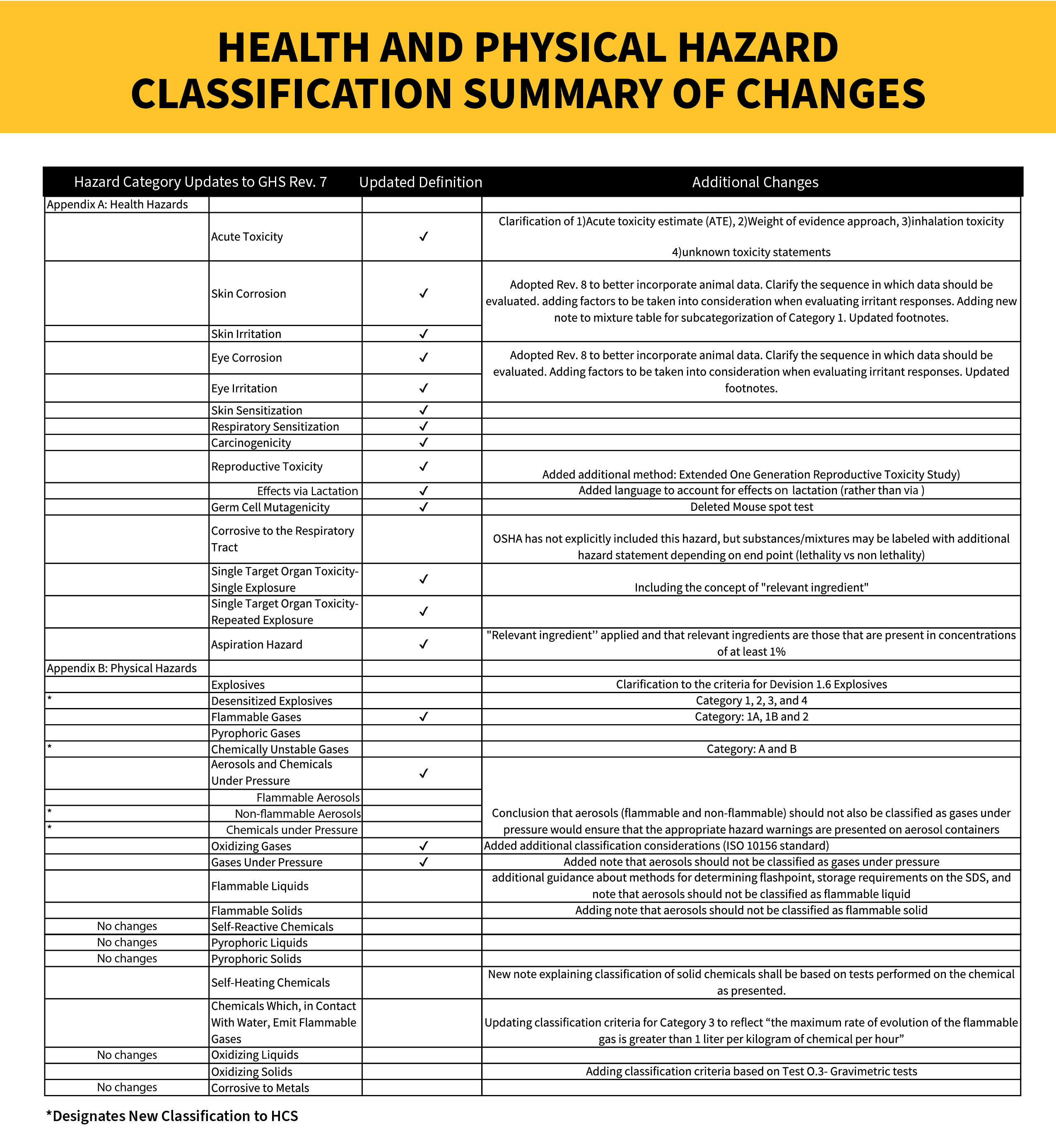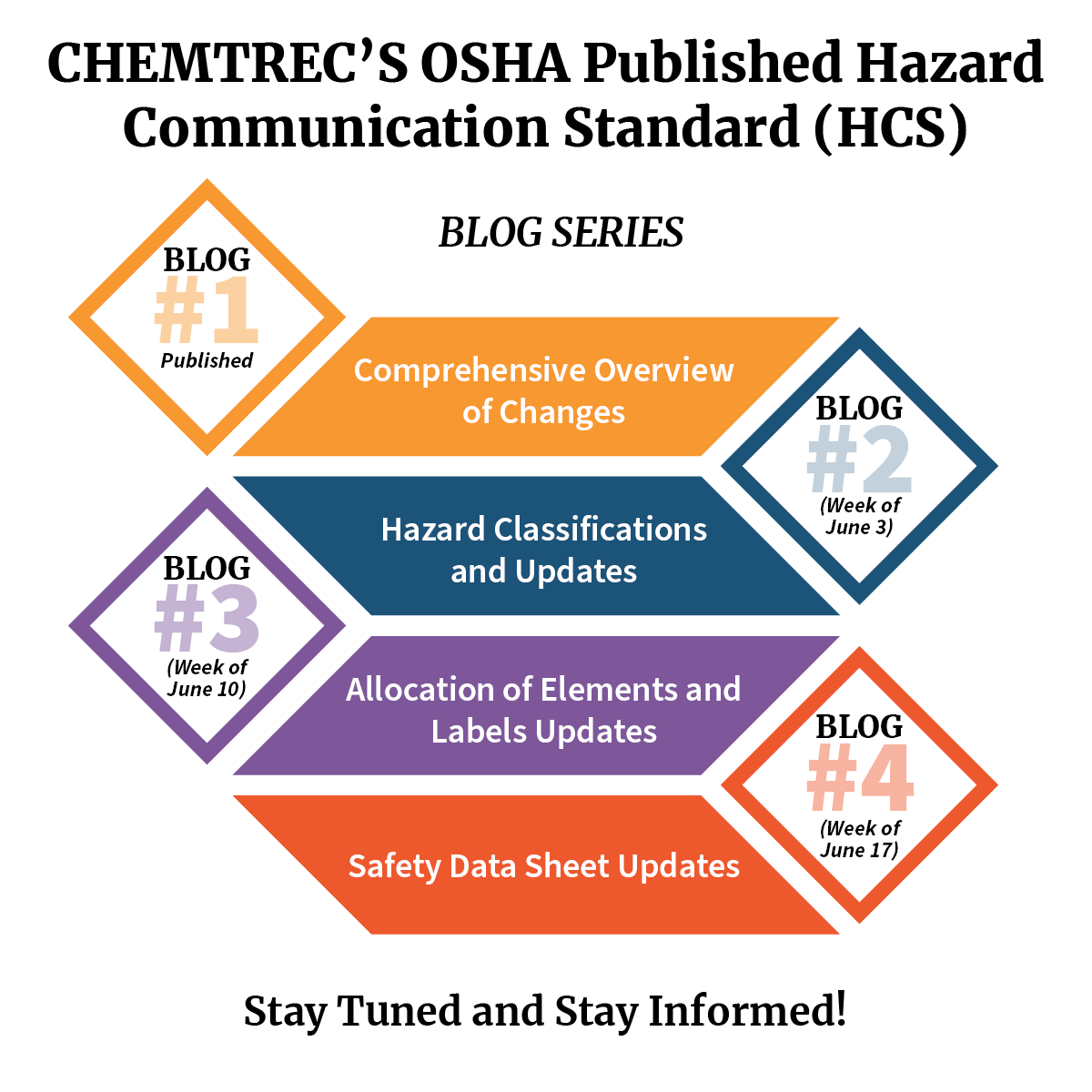OSHA’s Revised Hazard Communication Standard Published
OSHA’s Revised Hazard Communication Standard Published
Blog #1: Comprehensive Insight on OSHA Updates for 2024 by CHEMTREC
The Occupational Safety and Health Administration (OSHA) Hazard Communication Standard (HCS) final rule was published May 20, 2024, in the Federal Register. This OSHA 2024 update amends the HCS to conform to the United Nations’ Globally Harmonized System of Classification and Labelling of Chemicals (GHS). Focused primarily on GHS Revision 7, it addresses issues that arose during the implementation of the 2012 HCS update. This will provide better alignment with other U.S. agencies and international trading partners, while enhancing the effectiveness of the OSHA HCS.
CHEMTREC is here to provide you with its detailed insight into what this means and how CHEMTREC believes it will impact the workplace.
Impact of the HCS Update
U.S. Impact
OSHA expects these revisions to the Hazard Communication Standard to result in modest improvements in worker health and safety by increasing the quality of information on labels and safety data sheets (SDS) and by allowing workers and first responders to react quicker in an emergency. Net cost savings of the final OSHA HCS rule is estimated at $29.8 million per year at a seven percent discount rate. The main industries affected include oil and gas, chemical manufacturers, and wholesale trade. (Source: U.S. DOL, OSHA, Federal Registers, Hazard Communication Standard; Final Rule).
International Impact
Without reducing protections, the revised Hazard Communication Standard aligns more closely with U.S. trading partners, including Canada, Australia, New Zealand, and Europe. The decision to align with Canada has been a priority as it helps facilitate cooperation between the two countries, eases compliance for employers who participate in both markets, and strengthens worker protections by providing harmonized hazard communication standards across trade borders.
Implementation Timeline for OSHA SDS Update Requirements
- The effective date for the revised Hazard Communication Standard is July 19, 2024.
- Substance labels and safety data sheets must be updated to the new standard by January 19, 2026.
- Mixture labels and SDS must be updated to the new standard by July 19, 2027.
During the transition period, one can comply with this updated final rule, HCS 2012, or both.
CHEMTREC can help your organization comply with the HCS updates through our SDS Authoring service.
Major Changes to the Hazard Communication Standard
- Incorporation by Reference: The general incorporation by reference section, 29 CFR 1910.6 OSHA HCS, has been updated to include more recent national and international consensus standards. OSHA does not intend to require chemicals already classified using an earlier version of a consensus standard to be reclassified.
- 8 New Definitions: Bulk shipment, combustible dust, gas, liquid, solid, immediate outer package, physician or other licensed health care professional (PLHCP), and released for shipment were added as defined terms.
- Scope and Application, and Clarifying Amendment: The Scope and Application section of the HCS identifies the chemicals that are (and are not) covered by the revised Hazard Communication Standard. In the Hazard Classification section, OSHA made a clarifying revision to this paragraph to distinguish between hazards associated with the chemical and hazards associated with downstream use (e.g. chemical reactions). This change has been made to match the scope language and OSHA’s longstanding position that the HCS covers chemicals under normal conditions of use and foreseeable emergencies.
- Hazard Classification (Appendix A and B): The health and physical hazards covered by the HCS update and addressed in Appendices A and B include classification criteria consistent with the GHS. The health and physical hazard classifications are summarized in the following table:

- Allocation of Elements (Appendix C): Alignment with the GHS Rev. 7 includes:
a. Instruction to specify type of equipment where appropriate including hearing equipment.
b. Editorial changes made to improve clarity, correct simple omissions of a word or phrase, and more efficiently and concisely combine precautionary statements.
c. Specific storage changes for multiple hazards.
d. Removed the pyrophoric gases hazard class from OSHA Defined Hazards and incorporated the hazard into the flammable gases hazard class.
e. OSHA is not adopting any statements or instructions on consumer products. - Safety Data Sheets (Appendix D): Adding clarification to Sections 1, 2, 3, 8, 9, 10, 11, and 14 addresses common concerns explained in recent Letters of Interpretations (LOIs) and aligned with GHS Rev. 7. These revisions have been made to minimize future confusion and to overall enhance the safety of SDS users.
OSHA HCS Updates to Labels and Other Forms of Warning:
- Shipped Container Labels: Hazards resulting from a reaction with other chemicals from known or reasonably anticipated uses do not have to be addressed on shipped containers.
- Bulk Shipment Labels of Hazardous Chemicals: Labels may either be on the immediate container or may be transmitted with shipping papers, bills of lading, or other technological or electronic means so that the information is immediately available in print to workers on the receiving end of the shipment.
- DOT Pictograms: Where a DOT pictogram appears on a label for a shipped container, the appendix C pictogram for the same hazard is now allowed, but is not required, on the HCS label.
- Label Updates: Labels for chemicals must be revised within six months of becoming aware of any significant information regarding hazards of that chemical. Containers of the hazardous chemicals shipped after that time must be labeled with the new information. The HCS update includes some relief for relabeling, such as chemicals that have been released for shipment and are awaiting future distribution do not need to be relabeled.
- Small Containers Labeling Provisions: Labeling requirements are limited for containers for ≤ 100 milliliter (ml) capacity and ≤ 3 ml capacity.
- Trade Secrets: OSHA has updated Section 3 of safety data sheets to now allow concentration ranges to be withheld as a trade secret. When the concentration or concentration range is withheld as a trade secret, the chemical composition range would have to be provided in accordance with newly prescribed concentration ranges.
Learn More About the Revised Hazard Communication Standard
CHEMTREC will be blogging about a different topic each week throughout June to provide a breakdown of each major change to the Hazard Communication Standard.
- Week of June 3 – HCS Updates: Physical and Health Hazard Classifications
- Week of June 10 – HCS Updates: Allocation of Elements and Labels
- Week of June 17 – HCS Updates: Safety Data Sheets
- Week of June 24 – HCS Updates: FAQ on OSHA’s Revised Hazard Communication Standard

Please note: These are CHEMTREC opinions and should not be taken as OSHA’s interpretation. This blog’s main purpose is to inform readers of the published Hazard Communication Standard. To keep up with OSHA’s latest updates on the final HCS rule, follow CHEMTREC on social media: Facebook | X | LinkedIn
Request A Quote
Interested in learning more? Get an estimate for CHEMTREC services.
Request a Quote for SDS Authoring
Interested in SDS Authoring? We work with companies of all sizes and create Safety Data Sheets in several languages. Complete a request and we'll be in touch soon!
Contact Our Sales Team
Interested in chatting right now? Email our team at sales@chemtrec.com or call us at 1-800-262-8200, option 3, Monday through Friday, 8:30am-5:30pm ET.